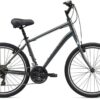Introduction:
Mountain biking is all about conquering challenging terrain, tackling steep climbs, and descending exhilarating trails. While many riders opt for multi-geared bikes to handle these diverse terrains, there’s a growing community of enthusiasts who prefer a simpler approach – the single-speed mountain bike. In this blog, we’ll delve into the world of single-speed mountain bikes, discussing their advantages, limitations, and the unique experiences they offer.
What is a Single-Speed Mountain Bike?
- Definition and Basics: A single-speed mountain bike, often referred to as a “singlespeed” or “SS” bike, has only one gear ratio. This means there’s no front or rear derailleur, cassette, or shifters.
- Fixed vs. Freewheel: Some single-speed bikes have a fixed gear, meaning the pedals turn when the wheel turns, while others have a freewheel, allowing coasting.
The Advantages of Riding Single-Speed Mountain Bikes:
Simplicity:
- Low Maintenance: Single-speed mountain bikes offer a straightforward design with fewer components. This simplicity translates into reduced maintenance requirements. Without derailleurs, shifters, and multiple gears, there are fewer parts that can go wrong. Riders spend less time adjusting and repairing their bikes, allowing for more time on the trails.
- Lightweight: Single-speed mountain bikes are often lighter compared to their multi-geared counterparts. This weight advantage is primarily due to their simplified design. Without the additional hardware of gears and multiple chainrings, the overall bike weight is reduced. A lighter bike enhances maneuverability and makes it easier to navigate challenging terrain, providing a more agile and responsive ride.
Skill Development:

- Improved Technique: Riding a single-speed mountain bike encourages riders to develop and refine their riding techniques. With a fixed gear ratio, cyclists must pay close attention to their cadence (pedal rotations per minute) and pedal efficiency. This heightened awareness leads to more precise and controlled pedal strokes, contributing to improved riding skills.
- Climbing Prowess: Climbing steep hills becomes a rewarding challenge on a single-speed mountain bike. The fixed gear requires riders to exert more effort when ascending, enhancing leg strength and endurance. Riders learn to optimize their climbing technique, finding the most efficient lines and pedal strokes to conquer challenging inclines. Over time, this results in increased climbing prowess and a sense of accomplishment.
Durability:
- Robust Design: Single-speed mountain bikes are renowned for their durability and rugged construction. These single-speed bikes are made to withstand the demands of rough mountain terrain. The absence of complex gearing systems means fewer components that can be susceptible to damage. As a result, single-speed bikes are known for their reliability, making them ideal for riders who tackle demanding off-road trails.
- Fewer Parts to Break: With fewer moving parts, single-speed mountain bikes experience fewer mechanical failures. There are fewer complicated components that can break or malfunction during rides, reducing the likelihood of on-trail breakdowns. This reliability allows riders to explore remote or challenging locations with confidence, knowing that their bike is less prone to issues.
The Challenges and Limitations:
Climbing:
- Steeper Challenges: Climbing steep hills on a single-speed mountain bike can be more demanding due to the fixed gear ratio. Riders must generate sufficient power and maintain a consistent cadence to conquer uphill sections. While this can enhance fitness and climbing skills, it can also be physically taxing at times, especially on extended ascents.
- Limited Gearing Options: Single-speed bikes lack the ability to shift to easier gears for challenging climbs. Cyclists must rely solely on their strength and technique to overcome steep terrain. This limitation can be challenging for riders facing extremely hilly or mountainous trails.
Descending:

- Speed Control: On descents, single-speed mountain bike riders may need to rely more on braking to control their speed. Without the option to shift into higher gears for rapid descents, riders must manage their downhill velocity through braking techniques. This can lead to increased brake wear and the need for careful speed modulation.
Terrain Variety:
- Best Suited for Consistent Terrains: Single-speed mountain bikes are best suited for relatively consistent terrains. While they excel on flowing trails with moderate inclines, they may struggle on highly variable landscapes that alternate between steep climbs and rapid descents. Riders may find it challenging to maintain momentum and efficiency in such terrain.
Selecting the Right Single-Speed Mountain Bike:
Frame Material:
- Consider Riding Style and Budget: When choosing a single-speed mountain bike, consider your riding style and budget. Frame materials vary, with options like steel, aluminum, titanium, and carbon. Steel offers durability, while carbon provides lightweight performance. Select a material that aligns with your preferences and intended use.
Gear Ratio:
- Match Terrain and Fitness: The choice of gear ratio is crucial. Ensure it matches the terrain you plan to ride and your fitness level. Steeper trails may require lower gear ratios for manageable climbs, while flatter terrain can accommodate higher gear ratios for increased speed.
Brakes:
- Rim or Disc Brakes: Decide between rim brakes or disc brakes based on your riding conditions. Disc brakes provide good and efficient stopping power and perform well in wet or muddy conditions. Rim brakes are lighter but may have limitations in challenging terrains.
Suspension:
- Choose Suspension Type: Determine if you want a hardtail (front suspension only) or full-suspension single-speed mountain bike. Hardtails are lighter and more efficient for climbing, while full-suspension bikes offer better comfort and control on rough descents.
The Thrill of Single-Speed Mountain Biking:
Connection to the Trail:
- Intimate Trail Connection: Riding a single-speed mountain bike offers a unique connection with the trail. The absence of gear shifting allows riders to focus entirely on their line choice, terrain assessment, and the natural flow of the trail. This enhanced connection enhances the overall riding experience.
Simplified Focus:
- Elimination of Gear Distractions: Without the distractions of shifting gears, riders can immerse themselves in the pure joy of the ride. The simplified focus encourages a deeper appreciation for the trail’s nuances, providing a more mindful and enjoyable biking experience.
Zen-like Riding:
- Heightened Sensation of Flow: Many single-speed riders describe their experience as “zen-like.” The absence of gear changes and distractions heightens the sensation of flow. Riders become one with the bike and the trail, achieving a state of mindfulness and seamless riding.
Conclusion:
Single-speed mountain biking offers a unique and rewarding experience for riders seeking simplicity, skill development, and a connection with the trails they ride. While it may not be for everyone, those who embrace the challenge often find it to be an exhilarating and meditative way to explore the mountains. Whether you’re a seasoned rider looking for a new adventure or a beginner eager to develop your skills, a single-speed mountain bike might just be the key to unlocking a world of trail-riding thrills.
















